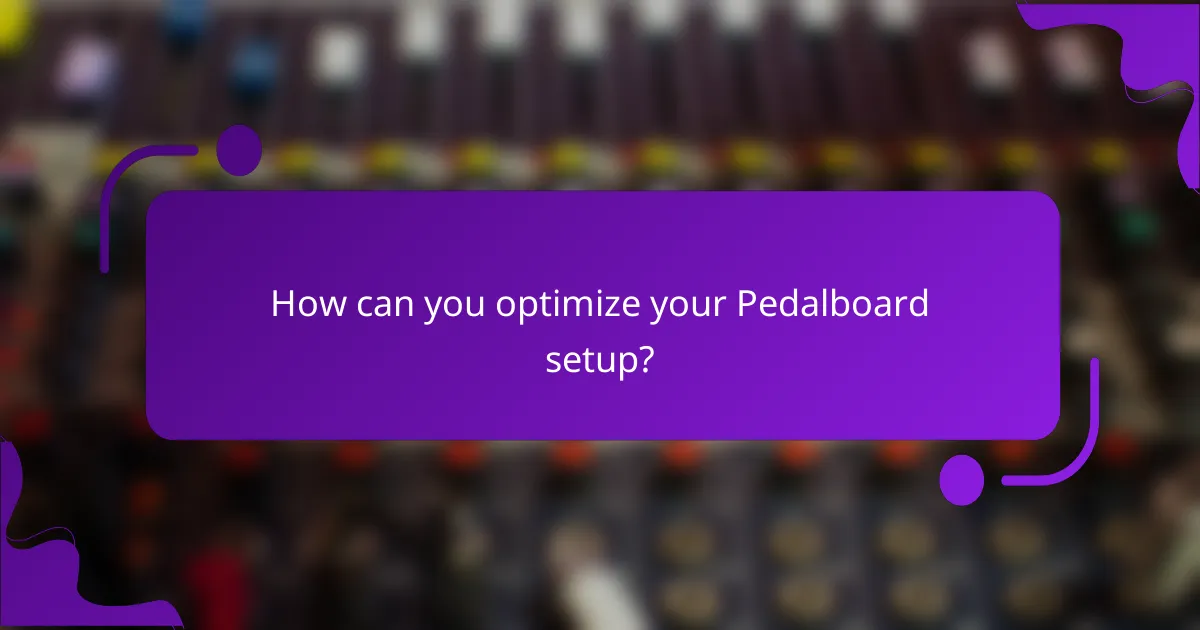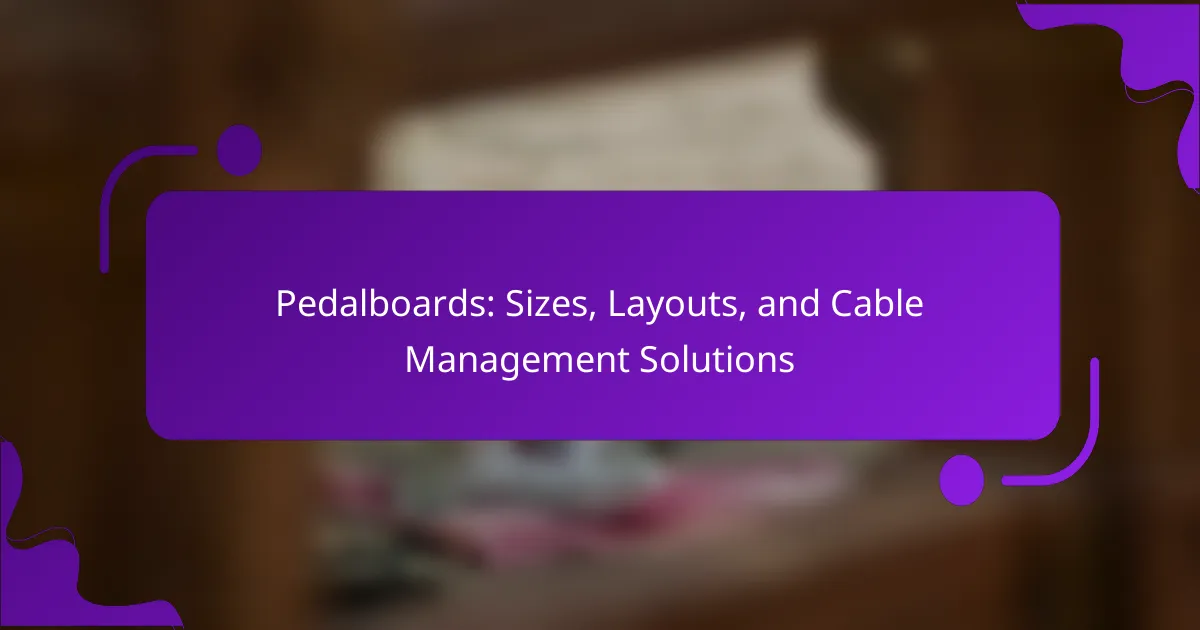Pedalboards are essential platforms for organizing and managing guitar effects pedals, providing musicians with a stable surface for convenient pedal arrangement. This article covers key considerations for selecting a pedalboard, including size, material, and layout, which impact pedal capacity, durability, and accessibility. It also emphasizes the importance of cable management to maintain a tidy setup and prevent signal interference. Furthermore, best practices for optimizing pedalboard setups, such as arranging pedals based on signal flow and securing connections, will be discussed to enhance performance efficiency.

What are Pedalboards and Their Purpose?
Pedalboards are platforms designed to hold and organize guitar effects pedals. They provide a stable surface for musicians to arrange their pedals in a convenient layout. This organization allows for easy access during performances. Pedalboards often feature built-in power supplies for powering multiple pedals. They can also include cable management solutions to keep wires tidy. The use of pedalboards improves workflow and reduces setup time for musicians. Additionally, they protect pedals from damage and environmental factors. Overall, pedalboards enhance the efficiency and effectiveness of a musician’s performance setup.
How do Pedalboards function in a music setup?
Pedalboards function as a centralized platform for organizing and controlling effects pedals in a music setup. They provide a structured way to connect multiple pedals, allowing musicians to create a desired sound. Each pedal modifies the audio signal in a specific way, such as adding distortion or reverb. The pedalboard facilitates easy access to these pedals during performances. It typically includes a power supply to ensure all pedals receive adequate power. Additionally, pedalboards can feature cable management systems to reduce clutter and tangling. This organization enhances the overall efficiency and effectiveness of a musician’s setup.
What are the essential components of a Pedalboard?
A pedalboard consists of several essential components. The primary component is the board itself, which provides a surface to mount effects pedals. Power supplies are crucial for delivering electricity to the pedals. Patch cables connect the pedals to each other, allowing signal flow. Velcro or adhesive strips help secure the pedals to the board. Additionally, a carrying case protects the pedalboard during transportation. Some setups may include a power strip for multiple power sources. Finally, cable management solutions keep the setup organized and reduce clutter. Each component plays a vital role in ensuring optimal performance and ease of use.
How do Pedalboards enhance sound quality?
Pedalboards enhance sound quality by organizing effects pedals in a structured manner. This organization minimizes signal loss and interference. A well-arranged pedalboard reduces unwanted noise and hum. Proper cable management ensures clean signal flow. Isolated power supplies on pedalboards prevent ground loops. High-quality patch cables contribute to better audio fidelity. Additionally, using a consistent signal path maintains tone integrity. Many musicians report improved clarity and response with optimized setups.
What types of Pedalboards are available?
There are several types of pedalboards available. Common types include flat pedalboards, angled pedalboards, and tiered pedalboards. Flat pedalboards provide a simple surface for placing pedals. Angled pedalboards allow for better visibility and access to pedals. Tiered pedalboards feature multiple levels for organized pedal placement. Additionally, there are powered pedalboards with built-in power supplies. These types cater to different needs and preferences among musicians. Each type offers unique advantages for pedal organization and accessibility.
What are the different sizes of Pedalboards?
Pedalboards come in various sizes to accommodate different setups. Common sizes include small, medium, and large. Small pedalboards typically measure around 18 to 24 inches in width. Medium pedalboards range from 24 to 36 inches wide. Large pedalboards can exceed 36 inches in width. These sizes cater to the number of pedals and the space available for musicians. The choice of size often depends on the musician’s needs and the complexity of their pedal setup.
How do layouts vary across different Pedalboard types?
Layouts across different pedalboard types vary significantly based on design, size, and intended use. For instance, flat pedalboards allow for a more straightforward arrangement of pedals, making it easier to access each one. In contrast, angled pedalboards provide a better visual and ergonomic angle for the player, facilitating quick adjustments during performances.
Additionally, compact pedalboards are designed for portability, often featuring limited space that requires careful placement of pedals. Larger pedalboards, on the other hand, can accommodate more pedals and complex setups, allowing for creative routing options.
Some pedalboards include integrated power supplies and cable management systems, which can influence layout decisions. The layout choice ultimately depends on the musician’s preferences and performance requirements.
Why is cable management important for Pedalboards?
Cable management is important for pedalboards to ensure organized and efficient setups. Proper cable management prevents tangling and reduces the risk of accidental disconnections during performances. It also minimizes signal interference, which can degrade sound quality. Additionally, well-managed cables enhance the aesthetic appeal of the pedalboard. This organization allows for easier troubleshooting and maintenance. Musicians can quickly identify issues without sifting through tangled wires. Overall, effective cable management contributes to a smoother performance experience.
What are common cable management solutions for Pedalboards?
Common cable management solutions for pedalboards include cable ties, Velcro straps, and cable sleeves. Cable ties provide a secure way to bundle cables together. They are often reusable and adjustable. Velcro straps allow for easy organization and repositioning of cables. They also prevent tangling and enable quick access. Cable sleeves cover multiple cables, offering a tidy appearance. They protect cables from wear and tear. Additionally, pedalboard trays and clips can hold cables in place. These solutions help maintain a clean setup and minimize signal interference. Effective cable management enhances usability and longevity of the pedalboard setup.
How does effective cable management improve performance?
Effective cable management improves performance by reducing signal interference and enhancing organization. Properly organized cables minimize clutter, which can lead to better airflow and easier access to equipment. This organization helps prevent tangling, which can cause damage to cables over time. Additionally, clear pathways for cables reduce the risk of tripping hazards. Studies indicate that effective cable management can lead to a 20% increase in workflow efficiency. This efficiency is particularly crucial in live performance settings where reliability is essential. Overall, effective cable management contributes to a cleaner, more functional setup.

What factors should you consider when choosing a Pedalboard?
When choosing a pedalboard, consider size, material, and layout. Size determines how many pedals can fit. A larger pedalboard accommodates more pedals but may be less portable. Material affects durability and weight. Common materials include wood and aluminum. Layout impacts accessibility and organization. A well-planned layout allows easy access to frequently used pedals. Cable management is essential for a clean setup. Effective cable management prevents tangling and signal interference. Lastly, portability is crucial for gigging musicians. A lightweight, compact design facilitates transportation.
How do size and layout influence your Pedalboard choice?
Size and layout significantly influence your pedalboard choice by determining how many pedals can fit and their arrangement. A larger pedalboard accommodates more pedals, enabling a broader range of effects. Conversely, a compact pedalboard is suitable for minimal setups or portability. The layout affects accessibility and usability. A well-organized layout allows for efficient switching between pedals during performance. Additionally, certain layouts, like tiered designs, enhance visibility and ease of use. Choosing the right size and layout ensures optimal performance and convenience while playing.
What are the advantages of larger versus smaller Pedalboards?
Larger pedalboards offer more space for multiple effects pedals, allowing for greater versatility in sound. They accommodate complex setups with various effects, enabling musicians to create diverse tones. Larger boards also provide better organization, reducing clutter and making it easier to manage connections. In contrast, smaller pedalboards are more portable and lightweight, making them ideal for traveling musicians. They often require fewer cables, simplifying setup and teardown processes. Smaller boards can also encourage minimalist setups, which can lead to more focused sound design. Overall, the choice between larger and smaller pedalboards depends on the musician’s specific needs and performance context.
How can layout choices impact your workflow?
Layout choices significantly impact workflow by influencing accessibility and efficiency. A well-organized layout minimizes the time spent searching for equipment. It allows for quick adjustments during performances or practice sessions. Clear cable management reduces clutter, preventing potential distractions. Studies show that organized workspaces can enhance focus and productivity. For musicians, a logical pedal arrangement facilitates smoother transitions between effects. This arrangement can lead to a more cohesive sound and better performance outcomes. Therefore, thoughtful layout choices are crucial for optimizing workflow in music settings.
What materials are commonly used in Pedalboard construction?
Common materials used in pedalboard construction include wood, aluminum, and plastic. Wood is often chosen for its durability and aesthetic appeal. Plywood is a popular choice due to its strength and lightweight nature. Aluminum provides a lightweight and sturdy option, often used in professional setups. Plastic is also utilized for its lightweight and cost-effective properties. These materials enhance portability and functionality. The choice of material can affect the pedalboard’s weight, durability, and overall appearance.
How do different materials affect durability and weight?
Different materials significantly influence the durability and weight of pedalboards. For instance, wood offers high durability but is heavier than plastic. Aluminum provides a lightweight alternative while maintaining good strength. Composite materials can balance weight and durability effectively. Steel is extremely durable but adds considerable weight. The choice of material impacts portability and longevity. For example, a wooden pedalboard may last longer but be cumbersome to transport. In contrast, an aluminum board is easier to carry but may not withstand rough handling as well.
What should you look for in a Pedalboard’s surface texture?
A pedalboard’s surface texture should provide adequate grip and durability. A textured surface prevents pedals from slipping during use. Look for materials like Velcro or rubber that enhance stability. These materials help secure pedals in place effectively. Additionally, the surface should be resistant to wear and tear. This ensures longevity and maintains grip over time. A smooth surface may lead to pedal movement, causing performance issues. Therefore, prioritize a surface that balances grip and durability for optimal functionality.

How can you optimize your Pedalboard setup?
To optimize your pedalboard setup, arrange pedals based on signal flow. Place distortion and overdrive pedals before modulation effects. This order enhances clarity and prevents unwanted noise. Use patch cables of appropriate length to minimize clutter. Shorter cables reduce capacitance, preserving tone quality. Secure pedals with Velcro or adhesive pads for stability during performances. Organize power supplies to avoid interference. Isolate power sources for digital pedals to prevent noise issues. Regularly check connections to ensure reliability. These practices lead to a more efficient and effective pedalboard setup.
What are best practices for arranging pedals on a Pedalboard?
Arrange pedals on a pedalboard by following a logical signal flow. Place the tuner first in the signal chain for accurate tuning. Next, position dynamic effects like compressors and overdrives. These pedals shape your sound before modulation effects. Modulation effects, such as chorus and flanger, should come next. Time-based effects like delay and reverb should be last. This order preserves audio clarity and maximizes tonal integrity. Additionally, use patch cables that are appropriately sized to minimize clutter. Secure pedals with Velcro or zip ties to prevent movement during performance. Regularly test the arrangement for optimal sound and functionality.
How can you prioritize pedal placement for accessibility?
Prioritizing pedal placement for accessibility involves arranging pedals for easy access and operation. Place frequently used pedals within immediate reach. Position pedals at an angle to enhance visibility and access. Ensure there is enough space between pedals to prevent accidental activation. Use color-coded labels for quick identification. Consider the height and foot size of users when determining placement. A study by the American Journal of Occupational Therapy highlights that ergonomic design improves user interaction with equipment. Proper placement enhances overall performance and user satisfaction.
What tips exist for effective cable routing on a Pedalboard?
Effective cable routing on a pedalboard involves organizing cables to minimize clutter and ensure functionality. Start by planning the layout before connecting any cables. Use cable ties or Velcro straps to bundle cables together. This keeps them organized and reduces tangling. Label each cable to identify its purpose easily. Route cables along the edges of the pedalboard for a cleaner look. Avoid sharp bends to prevent damage to the cables. Regularly check for loose connections to maintain optimal performance. These practices enhance both aesthetics and usability of the pedalboard setup.
What troubleshooting tips can help with Pedalboard issues?
Check all connections for secure and proper placement. Loose cables can lead to signal loss or noise. Inspect power supplies for functionality. A malfunctioning power supply can cause pedals to not operate correctly. Test each pedal individually to identify faulty units. This helps isolate issues effectively. Use high-quality cables to minimize signal degradation. Poor cables can introduce unwanted noise and interference. Ensure the pedal order is optimized for desired effects. Incorrect order can affect sound quality and performance. Regularly clean connections and pedals to prevent corrosion. This maintenance helps ensure reliable operation over time.
How can you identify and fix common connection problems?
Identify common connection problems by checking cable connections and ensuring they are secure. Loose cables can disrupt signal flow. Inspect the power supply to confirm it is functioning correctly. A faulty power supply can lead to device failure. Test each pedal individually to isolate issues. This helps determine if a specific pedal is malfunctioning. Use a multimeter to check for continuity in cables. Broken cables often cause connection problems. Additionally, ensure that all pedals are powered on and set to the correct settings. Proper settings are crucial for effective operation. Lastly, consult the pedal manuals for troubleshooting tips specific to each model. Manuals often contain valuable information for resolving issues.
What maintenance practices ensure your Pedalboard remains functional?
Regularly checking connections ensures your pedalboard remains functional. Loose cables can disrupt signal flow. Cleaning the pedalboard periodically prevents dust accumulation. Dust can interfere with pedal operation. Organizing cables neatly reduces wear and tear. Tangles can cause damage over time. Ensuring power supplies are stable prevents unexpected failures. Voltage fluctuations can harm pedals. Testing pedals regularly identifies issues early. Early detection allows for timely repairs.
Pedalboards are essential platforms for organizing and managing guitar effects pedals, providing stability and efficiency during performances. This article covers various aspects of pedalboards, including their purpose, types, sizes, and layouts, as well as the importance of effective cable management. Key components such as power supplies, patch cables, and surface textures are discussed, highlighting how they influence sound quality and usability. Additionally, best practices for optimizing pedalboard setups and troubleshooting common issues are provided, ensuring musicians can enhance their performance experience.
